Complete Solutions to Exercises of chapter FRICTION of Class 11 book with complete answers and questions
| Class 11 | PHYSICS |
| Chapter | FRICTION |
| HC VERMA | Exercises |
| Number Of Questions | 31 |
| Academic Year | 2023-24 |
A body slipping on a rough horizontal plane moves wioth a deceleationof `4.0 m/s^`. What is cofficient of kineic friction between the block and the plane?
View SolutionA block is projected along a rough horizontal road with a speed of 10 m/s. If the coefficient of kinetic friction is 0.10, how far will it travel before coming to rest?
View SolutionA block of mass m is kept on a horizontal table. If the static friction coefficient is `mu`., find the frictional force acting on the block.
View SolutionA block slides down an inclined surface of inclination `30^0` with the horizontal. Starting from rest it covers 8 m in the first two seconds. Find the coefficietn of kinetic friction between the two.
View SolutionSuppose the block of the previous problem is pushed down the incine witas force of 4N. How far will the block move in the first two seconds after starting from rest? The mass of the block is 4 kg.
View SolutionA body of mass 2 kg is lyign on rough inclined plane of inclination `30^0`. Find the mgnitude of the force parallel to the incline needed to make tkheblock move a. up the incline b. down the incline. Coefficient of static friction =0.2
View SolutionA body of mass 2 kg is lyign on rough inclined plane of inclination 30 0 . Find the mgnitude of the force parallel to the incline needed to make tkheblock move a. up the incline b. down the incline. Coefficient of static friction =0.2
Repeat part a. of problem 6 if the push is applied horizontally and not parallel to the incline.
View SolutionIn a children park an inclined plane is constructede with an angle of incline `45^0` in the middle part figure. Find the acceleration of a boy sliding on it if the friction coefficient between the cloth of the boy and the incline is `0.6 and g=10 m/s^2`.
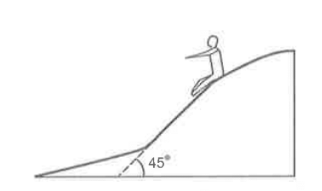
View SolutionA body starts slipping down an incline and moves half meter in half second. How ling will it take to move the next half meter?
View SolutionThe angle between the resultant contact force and the normal force exerted by a body on the other is called the angle of friction. Show that it `lamda` be the angle of friction and `mu` the coefficient of static friction. `lamdaletan^-1mu`.
View SolutionConsider the situation shown in figure. Calculate a. the acceleration of the 1.0 kg blocks, b. the tension in the strilng connecting the 1.0 kg blocks and c. the tension in the stting attached to 0.50 kg.
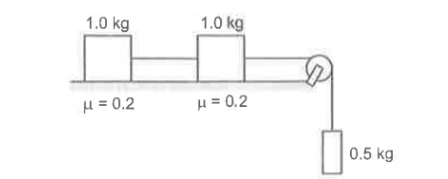
View SolutionIf the tension in the string in the figure. Is N and the acceleration of each block is `0.5 m/s^2`, find the friction coefficients at the two contacts with h blocks.
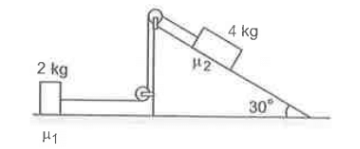
View SolutionThe friction coefficient between the table and the block shown in figure is 0.2. Find the tension in the two strings.

View SolutionThe friction coefficient between a road and the tyre of a vehicle is 4/3. Find the maximum incline the road may have so that once hard brakes are applied and the wheel starts skidding, the vehicle going down at a speed of 36 km/hr is stopped within 5m.
View SolutionThe friction coefficient bettween an athelete's shoes nd the ground is 0.90. Supose a superman wears these shoes and rces for 50 m. There is no upper limit n his capacity of running at high speeds. A. Find the minimum time tht he will have to take in completing the 50 m starting from rest. b. Suppose he takes exactly this minimum time to complete the 50 m, what minimum time will he take to stop?
View SolutionA car is going at a speed of 21.6 km/hr when it encounters a 12.8 m long slope of angle `30^0` figure. `1/(2sqrt3)`. Shwo tht no matter how hard the driver applies the brakes, tehcar will reach the bottim with a speed greater than 36 km/hr. Take `g=10 m/s^2`

View SolutionA car starts from rest on a half kilometer long bridge. The coefficiet of friction between the tyre and the road is 1.0. Show that one cannot drive thrugh the bridge in less than 10 s.
View SolutionFigure shows tow blocks in contact sliding down an inclined surface of inclination `30^0`. The friction coefficient between the block o fmass 2.0 kg and the incline is `mu_1` and that between the block of mas 4.0 kg and the incline is `mu_2`. Calculate teh acceleration of the 2.0 kg bloc if a. `mu_1=0.20 and mu_2 =0.30 b. mu_1=0.30 and mu_2=0.20. `Take `g=10m/s^2`.

View SolutionTwo masses `M_1 and M_2` are connected by a light rod and the system is slipping down a rough incline of angle `theta` with the horizontal. The friction coefficient at both the contacts is `mu`. Find the acceleration of the system, and the force by the rod on one of the blocks.
View SolutionA block of mass M is kept on as rough horizontal surface. The coefficient of static frictionbetween the block and the surface is `mu`. The block is to be pulled by applying a force to it. What minimum force is needed to slide the block? In which direction should this force act?
View SolutionThe friction coeficient bettween the board and the floor shownin filgure is `mu`. Find the maximum force that the man can exert on the rope so tht the board does not slipon the floor.

View SolutionA 2 kg block iks placed over a 4 kg block and both are plced on a smooth horizontal surfae. The coefficient of friction between the blocks is 0.20. Find theacceleration of the two blocks if a horizontal force os 12 N is applied to a. the upper block, b. the lower block. Take `g=10 m/s^2`.
View SolutionFind the accelerations `a_1,a_2,a_3` of the three blocks shown in figure if a horizontal force of 10 N is applied on a. 2 kg block, b. 3 kg block, c. 7 kg block. Take `g=10 m/s^2`.
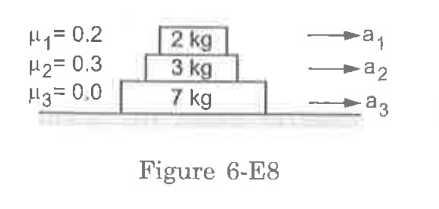
View SolutionThe friction coefficient between the two blocks shown in figure is `mu` but the floor is smooth. A. What maximum horizontal force F can be applied without disturbing the equilibrium of the systme? b.suppose the horizontal force applied is double of that found in part a. Findthe accelerations of the two masses.
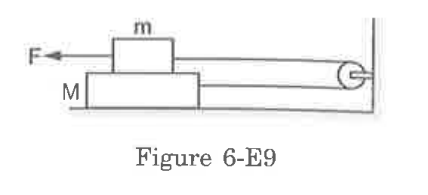
View SolutionSuppose the entire system of the previous question is kept inside an elevator which is coming down with an acceleration altg. Repeat parts a. and b.
View SolutionConsider the situation shown in figure. Suppose a small electric field E exists in the space in the vertically upward direction and the upper block carries a positive charge Q on its top surface. The friction coefficient between the two blocks is `mu` but teh floor is smooth. what maximum horizontal force F can be applied without disturbing the equilibrium?
View SolutionA block of mass m slips on a rough horizontal table under the action of horiozontal force applied to it. The coefficient of friction between the block and the table is `mu`. The table does not move on the floor. Find the total frictional force aplied by the floor on the legs of the table. Do you need the friction coefficient between the table and the floor or the mass of the table ?
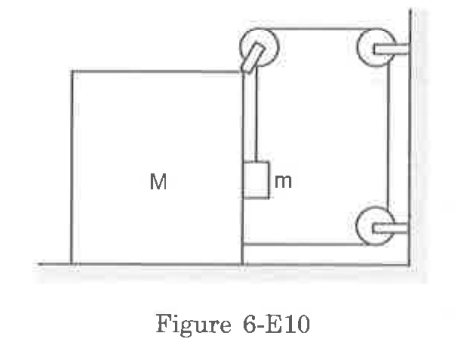
View SolutionFind the acceleration of the block of mass M in the situation of figure. The coefficient of friction between the two blocks is `mu_1` and that between the bigger block and the ground is `mu_2`.
View SolutionA block of mass 2 kg is pushed against a rough vertical wall with a force os 40 N. Coefficient of static friction being 05. Another horizontal force is 15 N, is applied on the block in a direction paralle to the wall. Will the block move? If yes in which direction? If no, find the frictional force exerted by the wall on the block.
View SolutionA person (40 kg) is managing to be at rest between two verticle walls by pressing one wall A by hi hands and feet and the other wall B by his back figure. Assume that the friction coefficient between his body and the walls is 0.8 and that limiting friction acts at all the contacts. a. show that the person pushes the two walls with equal force. b. find the normal force exerted by either wall on the person Take `g=10 m/s^2`.
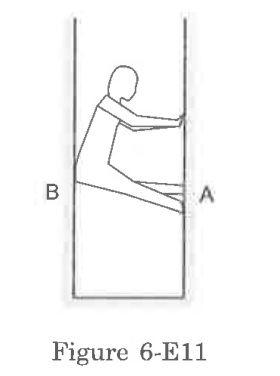
View SolutionFigure shows a small block of mass m kept at the left end of a larger block of mass M and length l. The system canslide on a horizontal road. The system is started towards right with an initia velocity v. The friction coefficient between the road and the bigger block is `mu` and that between the block is `mu/2`. Find the time elapsed before the smaller blocks separates from the bigger block.
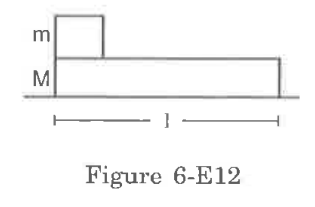
View Solution
Exercises questions and complete solutions for chapter FRICTION of HC VERMA PHYSICS (HINGLISH) of Class 11